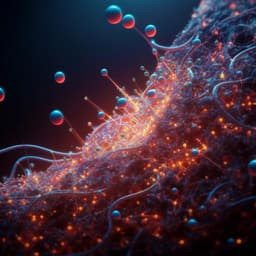
Chemistry
Solid solution for catalytic ammonia synthesis from nitrogen and hydrogen gases at 50 °C
M. Hattori, S. Iijima, et al.
This groundbreaking research by Masashi Hattori, Shinya Iijima, Takuya Nakao, Hideo Hosono, and Michikazu Hara introduces a revolutionary low-temperature ammonia synthesis method using the stable catalyst cubic CaFH, achieving ammonia production at just 50 °C with an astonishingly low activation energy of 20 kJ mol⁻¹. A new era of energy-efficient catalysis is on the horizon!
~3 min • Beginner • English
Introduction
The Haber-Bosch process sustains global food production but consumes ~2% of global energy and generates ~3% of CO₂ emissions. Conventional iron-based catalysts operate effectively only above ~350 °C, where equilibrium limits ammonia yield and necessitate high pressures, increasing energy demand. Although lower temperatures (~50 °C) would thermodynamically favor high ammonia yields (>98% irrespective of pressure), most heterogeneous catalysts lose activity below 100–200 °C due to kinetic barriers, primarily the difficulty of N₂ dissociation. Prior observations show that reaction rates deviate from Arrhenius predictions at low temperatures, with essentially no detectable NH₃ formation below ~150 °C over standard catalysts, despite sufficient electron-donating capability of transition metals not being strongly temperature dependent below 200 °C. The research question is how to realize efficient, stable ammonia synthesis catalysis at temperatures near 50 °C by enhancing electron donation to facilitate N₂ activation while maintaining catalyst stability.
Literature Review
- Conventional Fe and Ru-based catalysts require high temperatures, showing negligible activity below 100–200 °C despite promoter strategies; ammonia desorbs from TM surfaces below room temperature, so low-T inactivity is not simply due to NH₃ poisoning.
- Electron donation from supports/promoters to TM d-orbitals enhances N₂ π* back-donation and dissociation. Systems such as Cs-Ru/MgO and Ru on electrides (e.g., C12A7:e−) show improved activity at higher temperatures but still lose activity near/below 200 °C.
- Hydride-containing supports (e.g., CaH₂, Ca₂NH, BaH₂-BaO mixtures) can donate electrons after H abstraction, improving N₂ activation; yet Ru/CaH₂ loses activity below ~150–200 °C, correlating with the onset temperature for H₂ desorption.
- Homogeneous systems can reduce N₂ to NH₃ at low temperatures using specific reagents but are not reusable for practical gas-phase N₂/H₂ catalysis.
These insights suggest that creating a stable, stronger electron-donating environment at low temperature, by facilitating hydrogen release and electron accumulation (electride-like states), could enable low-temperature NH₃ synthesis.
Methodology
Catalyst design and preparation:
- Strategy: Introduce F⁻ into CaH₂ to form a cubic CaFH solid solution (CaF₁.₀H₁.₀), strengthening Ca–F and weakening Ca–H bonds. This lowers the H release temperature, enabling electron accumulation at H vacancies, reducing the surface work function and enhancing electron donation to Ru and adsorbed N₂.
- CaH₂–BaF₂ pretreatment: A mixture of 87 mol% BaF₂ and 13 mol% BaH₂ was heated at 400 °C for 10 h in Ar (15 mL min⁻¹) to produce a disordered, modified BaF₂ (broad BaF₂ XRD peaks, no BaH₂ peaks).
- Formation of CaFH on CaH₂: Simple mixtures of CaH₂ and modified BaF₂ (Ca/Ba atomic ratios 98:2, 9:1, 5:1, 3:1) were heated at 340 °C for 10 h in H₂ (2.5 mL min⁻¹). XRD showed asymmetric (200) reflections characteristic of cubic CaF₁.₀H₁.₀; XPS Ca 2p shifts (346.5 eV vs 347.3 eV for CaH₂) supported CaFH formation on CaH₂ surfaces. BaF₂ → BaH₂ transformation occurred; CaF₂ peaks were absent, indicating in situ CaFH solid solution on CaH₂.
- Ru deposition (Ru/CaFH, 12 wt% Ru): Chemical vapor deposition using Ru(acac)₃ by two equivalent methods. Method 1: deposit on preformed CaFH (98:2 Ca/Ba) at 260 °C (2 h) then 340 °C (10 h) in H₂. Method 2 (used for results): co-load Ru(acac)₃ on CaH₂ + modified BaF₂ mixture (98:2), then heat at 260 °C (2 h) and 340 °C (10 h) in H₂.
- Comparative materials: CaF₂H₂−x–CaF₂ solid solutions (1.0 ≤ x ≤ 1.6) prepared by mixing CaF₂ and CaH₂, heating at 550 °C for 20 h in Ar; Ru/CaF₂H₂−x–CaF₂ (x=1) prepared by CVD of Ru(acac)₃ followed by 340 °C in H₂. Ru/CaH₂, Ru/BaH₂, and Ru/BaH₂–BaO (3 mol% BaO, 97 mol% CaH₂) were prepared analogously (10 wt% Ru). Cs-Ru/MgO (10 wt% Ru) was prepared by impregnating MgO with Ru₃(CO)₁₂ in THF, decomposing at 450 °C in vacuum, then doping with Cs₂CO₃ in ethanol and drying.
Catalytic testing:
- Fixed-bed silica-glass reactor, catalyst mass 0.1 g. Standard activation at 340 °C in N₂–H₂ (N₂:H₂=1:3, 60 mL min⁻¹; WHSV 36,000 mL g_cat⁻¹ h⁻¹) at 0.1 MPa until stable (>30 h). Cool to <20 °C under N₂ for 5 h until no NH₃ detected. Low-temperature tests conducted by heating to specified temperatures under N₂–H₂ (5:1, 60 mL min⁻¹). NH₃ quantified by online mass spectrometry and ion chromatography (NH₃ trapped in 5 mM H₂SO₄; conductivity detection). Rates were repeatable within <10% error and proportional to catalyst weight (0.05–5.00 g).
- Long-term stability: Continuous operation at 200 °C and 340 °C; XRD and surface F/Ca ratios checked post-reaction; HF monitored (not detected).
- Isotopic experiment (N₂ + D₂): Ru/CaFH prepared in situ (260 °C 2 h, 300 °C 10 h in H₂), cooled to 180 °C in Ar for 5 h. N₂ (5 mL min⁻¹) and D₂ (15 mL min⁻¹) introduced at 0.1 MPa; outlet analyzed by mass spectrometry to track NH₃/NDxHy formation.
Characterization:
- XRD (Cu Kα) for phase identification; BET N₂ adsorption at −196 °C; SEM/EDX and TEM for morphology (Ru particle size ~3–4 nm; support particles 0.5–3 μm; Ru/CaFH surface area ~30 m² g⁻¹; CaFH surface area ~10 m² g⁻¹ cited for formed surface layer).
- H₂-TPD: Ar flow (30 mL min⁻¹), heating 1 °C min⁻¹, TCD and MS detection to determine H₂ desorption onset.
- XPS (Mg Kα) with glovebox transfer to avoid air exposure; binding energies referenced to Au 4f₇/₂.
- FT-IR of adsorbed N₂ at 25 °C (6–15 kPa N₂) using self-supported disks in sealed cell; ν(N≡N) band positions compared across catalysts; δ(NH) band around 1600 cm⁻¹ monitored.
Computations:
- DFT slab supercell models of CaFH(111) (most stable plane) with >20 Å vacuum; plane-wave cutoff 500 eV; k-point mesh 2×2×1; surface relaxation to forces <0.01 eV Å⁻¹; slab thickness 7–10 layers. Calculated work functions for CaFH with/without H or F defects; compared to CaH₂ with H defects to assess electron-donating propensity.
Key Findings
- A Ru nanoparticle-deposited CaFH solid solution (Ru/CaFH) enables ammonia synthesis from N₂ and H₂ at 50 °C with an apparent activation energy of 20 kJ mol⁻¹, less than half that of conventional catalysts (>40 kJ mol⁻¹).
- H₂-TPD shows the onset of H₂ desorption for Ru/CaFH at approximately room temperature to 50 °C, far lower than for Ru/CaH₂, correlating with retention of low-temperature catalytic activity. Ru/CaFH TPD overlaps those of Ru/CaH₂ and Ru/CaFₓH₂−x–CaF₂ (x=1), indicating surface coexistence of CaFH and CaH₂ domains.
- XRD and XPS confirm formation of cubic CaF₁.₀H₁.₀ solid solution on CaH₂ surfaces after heating CaH₂–BaF₂ mixtures at 340 °C in H₂; Ca 2p at 346.5 eV (vs 347.3 eV for CaH₂). Surface F/Ca on Ru/CaFH is ~0.08, supporting partial surface coverage by CaFH.
- DFT estimates a low work function for CaFH(111) with H vacancies (φ ≈ 2.2 eV) vs CaH₂ with H defects (φ ≈ 2.7 eV), comparable to metallic K (2.3 eV), indicating stronger electron-donating capability due to electron repulsion from F⁻ elevating trapped-electron energy.
- FT-IR of adsorbed N₂ at 25 °C: ν(N≡N) bands at 2030–2150 cm⁻¹ on Ru/CaFH (lower than 2100–2250 cm⁻¹ on Ru/CaH₂), evidencing stronger back-donation to N₂ π*; δ(NH) band near 1600 cm⁻¹ observed, consistent with N₂ dissociation and hydrogenation occurring even at 25 °C.
- Isotopic transient (N₂ + D₂ at 180 °C): Immediate formation of NH₃ (m/z 17) followed by NDH₂ (m/z 18) and ND₂H (m/z 19); ND₃ (m/z 20) not observed within 10 min. This indicates that H from the CaFH bulk participates early via migration to Ru and reaction with N adatoms.
- Low-temperature activity and stability: Ru/CaFH shows NH₃ formation rates of 50, 75, 120, and 190 μmol g⁻¹ h⁻¹ at 50, 75, 100, and 125 °C, respectively. The apparent pre-exponential factor A and Ea from 50–125 °C (Ea ≈ 20 kJ mol⁻¹, A ≈ 10) match those from 275–340 °C (Ea ≈ 23 kJ mol⁻¹, A ≈ 12), and are pressure-independent between 0.1 and 0.9 MPa, suggesting a consistent mechanism and active sites across wide conditions.
- Benchmarking: Conventional catalysts (commercial Fe, Cs-Ru/MgO, Ru/BaH₂–BaO, Ru/CaH₂) show negligible activity below 100–200 °C, whereas Ru/CaFH is active at 50 °C. At 200 °C, the catalyst weight required to reach equilibrium yield (CWEY) for Ru/CaFH is about half that of Ru/Ba–Ca(NH₂)₂ and Ru/BaH₂–BaO.
- Durability: At 200–340 °C, Ru/CaFH maintains constant NH₃ production for >100 h under near-equilibrium conditions; at 340 °C, the cumulative NH₃ exceeded the catalyst amount (~24 mmol) within 100 min. Post-reaction XRD and F/Ca (0.08) remained unchanged; no HF detected, indicating structural and chemical stability.
- Control comparisons: Ru/BaH₂ is far less active than Ru/CaF₂H₂−x–CaF₂ (x=1), implicating CaFH as the primary active support phase; conventional high-temperature-prepared CaF₂H₂−x–CaF₂ (x=1) has low surface area (~1 m² g⁻¹) and inferior activity vs CaFH formed at 340 °C on CaH₂ surfaces (surface area ~10 m² g⁻¹ for CaFH layer; Ru/CaFH total ~30 m² g⁻¹).
Discussion
Introducing F⁻ into CaH₂ to form a CaFH solid solution strengthens Ca–F bonds and weakens neighboring Ca–H bonds, enabling Ru to abstract H at much lower temperatures. The resulting H vacancies trap electrons; electrostatic repulsion from adjacent F⁻ raises their energy and lowers the surface work function, creating a robust, low-temperature electron-donating environment (electride-like). This enhances back-donation from Ru to N₂ π* orbitals, facilitating N₂ dissociation—the rate-determining step in ammonia synthesis—at temperatures down to 50 °C. Spectroscopic (FT-IR) and isotopic (N₂/D₂) evidence corroborate that N₂ dissociation and subsequent hydrogenation proceed at or near room temperature with H supplied from the CaFH bulk. Kinetic parameters (Ea and A) are consistent across wide temperature and pressure ranges, indicating a stable mechanism and active site ensemble. Compared to state-of-the-art catalysts, Ru/CaFH achieves lower activation energy, activity at unprecedented low temperatures, reduced catalyst mass to reach equilibrium at 200 °C, and long-term stability without fluorine loss, addressing the central barrier to low-temperature NH₃ synthesis in the Haber–Bosch context and supporting pathways to lower energy and potentially lower-carbon ammonia production.
Conclusion
This study demonstrates a stable, electron-donating Ru/CaFH catalyst that enables ammonia synthesis from N₂ and H₂ at 50 °C with an apparent activation energy of 20 kJ mol⁻¹. The CaFH solid solution formed at low temperature weakens Ca–H bonds, promotes facile H abstraction and electron accumulation at H vacancies, and markedly enhances electron donation to Ru, thereby facilitating N₂ dissociation at low temperature. The catalyst shows significant activity at 50–125 °C, reduced catalyst requirement for equilibrium yield at 200 °C relative to leading benchmarks, and long-term stability at elevated temperatures with unchanged structure and composition. These findings provide a practical route to low-temperature, energy-efficient ammonia synthesis by designing stable, low-work-function, electron-donating supports through anion substitution in hydrides.
Limitations
Related Publications
Explore these studies to deepen your understanding of the subject.







